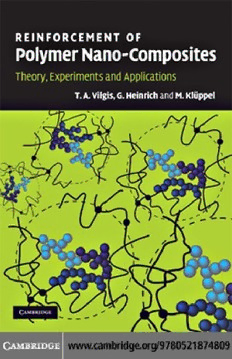
Reinforcement of Polymer Nano-Composites PDF
Preview Reinforcement of Polymer Nano-Composites
This page intentionally left blank REINFORCEMENT OF POLYMER NANO-COMPOSITES Reinforced rubber allows the production of passenger car tires with improved rollingresistanceandwetgrip.Thisbookprovidesin-depthcoverageofthephysics behindelastomerreinforcement,withaparticularfocusonthemodificationofpoly- merpropertiesusingactivefillerssuchascarbonblackandsilica.Theauthorsbuild afirmtheoreticalbasethroughadetaileddiscussionofthephysicsofpolymerchains andmatricesbeforemovingontodescribereinforcingfillersandtheirapplications intheimprovementofthemechanicalpropertiesofhigh-performancerubbermate- rials. Reinforcement is explored on all relevant length scales, from molecular to macroscopic,usingavarietyofmethodsrangingfromstatisticalphysicsandcom- puter simulations to experimental techniques. Presenting numerous technological applicationsofreinforcementinrubbersuchastiretreadcompounds,thisbookis idealforacademicresearchersandprofessionalsworkinginpolymerscience. T.A.Vilgis is Professor of Theoretical Physics at the University of Mainz and a researcher at the Max Planck Institute for Polymer Research. He is a member of severalscientificsocietiesincludingtheGermanPhysicalSociety,EPS,andAPS. He has written more than 250 scientific papers, three popular science books and twoscientificcookbooks. G.HeinrichisProfessorofPolymerMaterialsatTechnischeUniversitätDresden andisalsoDirectoroftheInstituteofPolymerMaterialswithintheLeibnizInstitute of Polymer Research. He has written or contributed to over 250 scientific papers andbookchaptersonpolymerscience. M. Klüppel is a Lecturer in Polymer Materials at Leibniz University, Hannover and Head of the Department of Material Concepts and Modelling at the German Institute of RubberTechnology (DIK). He has published more than 150 scientific papersandisamemberoftheGermanPhysicalSociety,theGermanRubberSociety, andtheRubberDivisionofACS. REINFORCEMENT OF POLYMER NANO-COMPOSITES Theory, Experiments and Applications T.A.VILGIS Max-Planck-InstitutfürPolymerforschung,Mainz G.HEINRICH Leibniz-InstitutfürPolymerforschung,Dresden M.KLÜPPEL DeutschesInstitutfürKautschuktechnologie,Hannover CAMBRIDGE UNIVERSITY PRESS Cambridge, New York, Melbourne, Madrid, Cape Town, Singapore, São Paulo, Delhi, Dubai, Tokyo Cambridge University Press The Edinburgh Building, Cambridge CB2 8RU, UK Published in the United States of America by Cambridge University Press, New York www.cambridge.org Information on this title: www.cambridge.org/9780521874809 © T.Vilgis, G.Heinrich and M.Klüppel 2009 This publication is in copyright. Subject to statutory exception and to the provision of relevant collective licensing agreements, no reproduction of any part may take place without the written permission of Cambridge University Press. First published in print format 2009 ISBN-13 978-0-511-60501-7 eBook (NetLibrary) ISBN-13 978-0-521-87480-9 Hardback Cambridge University Press has no responsibility for the persistence or accuracy of urls for external or third-party internet websites referred to in this publication, and does not guarantee that any content on such websites is, or will remain, accurate or appropriate. Contents Preface ix Acknowledgement xii 1 Introduction 1 2 Basicsaboutpolymers 10 2.1 Gaussianchains–heuristicintroduction 10 2.2 Gaussianchains–pathintegrals 12 2.3 Self-interactingchains 15 3 Many-chainsystems:meltsandscreening 19 3.1 Somegeneralremarks 19 3.2 Collectivevariables 20 3.3 Thestatisticsoftaggedchains 26 4 Rubberformation 31 4.1 Classicaltheoryofgelation 31 4.2 Percolation 34 4.3 Vulcanization 37 5 Theelastomermatrix 40 5.1 Generalremarks 40 5.2 TheGaussiannetwork 42 5.3 Entanglementsandthetubemodel:amateriallaw 45 5.3.1 Entanglementsliding 47 5.3.2 Finiteextensibility 49 5.3.3 Tubeandsliplinks 52 v vi Contents 5.4 Experiments 53 5.4.1 Thestress–strainrelationship 53 5.4.2 Theextendedtubemodelofrubberelasticity 55 5.4.3 Testingofthemodel 59 6 Polymersoflargerconnectivity:branchedpolymersand polymericfractals 64 6.1 Preliminaryremarks 64 6.2 D-dimensionallyconnectedpolymersinagoodsolvent 64 6.3 D-dimensionallyconnectedpolymersbetweentwoparallel platesinagoodsolvent 66 6.4 D-dimensionallyconnectedpolymersinacylindricalpore(good solvent) 68 6.5 Meltsoffractalsinrestrictedgeometries 71 6.6 Oncemorethedifferences 74 7 Reinforcingfillers 75 7.1 Fillersfortherubberindustry 75 7.2 Carbonblack 77 7.2.1 Morphologyofcarbonblackaggregates 77 7.2.2 Surfaceroughnessofcarbonblacks 84 7.2.3 Energydistributionofcarbonblacksurfaces 92 7.3 Silica 96 8 Hydrodynamicreinforcementofelastomers 101 8.1 Reminder:Einstein–Smallwood 101 8.2 Rigidfilleraggregateswithfractalstructure 103 8.2.1 Effectivemediumtheoryandlinearelasticity 106 8.2.2 Screeninglengths 109 8.2.3 Reinforcementbyfractalaggregates 110 8.3 Core–shellsystems 111 8.3.1 Uniformsoftsphere 112 8.3.2 Softcore/hardshell 112 8.3.3 Hardcore/softshell 115 9 Polymer–fillerinteractions 118 9.1 Generalremarksandscaling 118 9.1.1 Flatsurface 119 9.1.2 Generalizationforfractalsurfaces 120 Contents vii 9.2 Variationalcalculationstatics 121 9.2.1 Variationalcalculation 121 9.3 TrialHamiltonian 122 9.3.1 Minimizationofthefreeenergy 123 9.3.2 Effectiveinteractionstrength 126 9.4 Somefurtherremarksontheinterpretation 130 9.4.1 Modelingbyrandompotentials 131 9.4.2 Annealedandquencheddisorder 134 9.4.3 Dynamicsoflocalizedchains–freezing,glasstransition atfillersurfaces 135 9.5 Equationofmotionforthetimecorrelationfunction 137 9.5.1 Langevindynamics 137 9.5.2 Salf-consistentHartreeapproximation 139 9.5.3 Equationofmotion 142 9.6 Dynamicbehaviorofthechain 144 9.6.1 Anomalousdiffusion 144 9.6.2 Center-of-massfreezing 146 9.6.3 Rousemodesfreezingandatwomodetoymodel 147 9.7 Numericalanalysis 148 9.7.1 Bifurcationdiagram 149 9.8 Contributiontothemodulus 151 10 Filler–fillerinteraction 153 10.1 Fillernetworkinginelastomers 153 10.1.1 Flocculationoffillersduringheattreatment 153 10.1.2 Kineticsoffillerstructuresunderdynamicexcitation 156 10.2 Dynamicsmall-andmedium-strainmodeling–thePayneeffect 161 10.2.1 TheKrausmodel 161 10.2.2 Theviscoelasticmodel 164 10.2.3 ThevanderWalle–Tricot–Gerspacher(WTG)model 169 10.2.4 Thelinks–nodes–blobs(LNB)model 171 10.2.5 Themodelofthevariablenetworkdensity 172 10.2.6 Thecluster–clusteraggregation(CCA)model 174 10.3 Stress-softeningandquasistaticstress–strainmodeling– theMullinseffect 182 10.3.1 Thedynamicflocculationmodel 182 10.3.2 TheKantor–Webmanmodelofflexiblechainaggregates 193 References 196 Index 204
